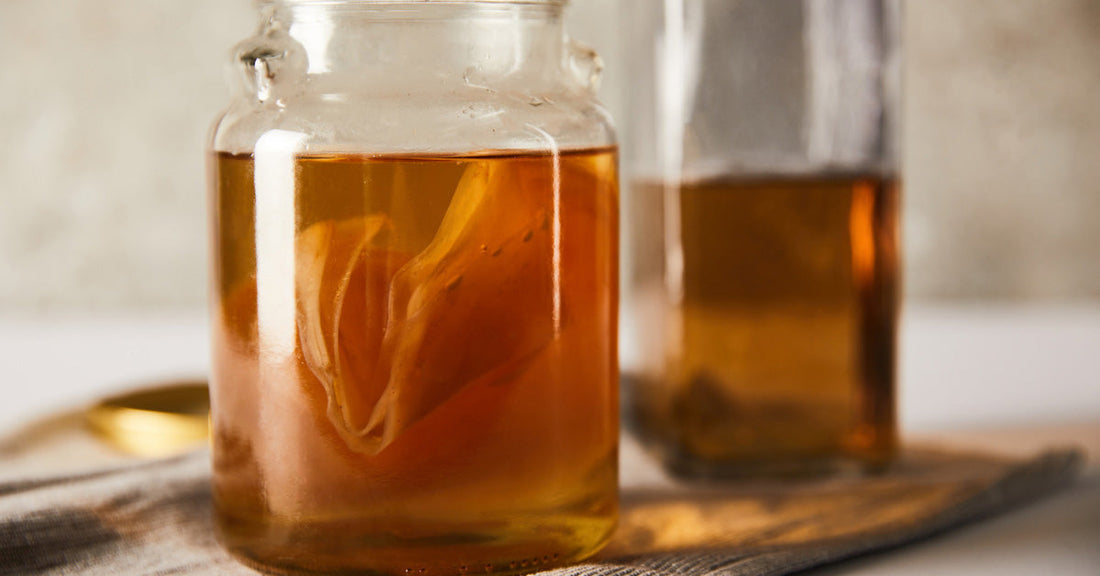It's finally summer and any reason to cool off is a good one. Kombucha drinks are becoming especially popular in the warmer months and you may want to brew your own to save a few dollars at the store but also to
the simple pleasure of flavoring your own kombucha.
After turning my kitchen into a home kombucha making factory, I'm sharing with you my tips and tricks for making a successful drink. I hope you enjoy brewing this delicious and refreshing drink
and probiotic-filled drink. The technique may seem a bit daunting at first, but making kombucha will quickly prove to be a source of real pleasure!
But first, what is kombucha?
Kombucha is a naturally carbonated beverage resulting from the fermentation of a symbiotic culture between bacteria and yeast (scoby or mother). The finished product is slightly refreshing, energizing and full of probiotics.
The mother is the most important element of the process, it is the basis of the fermentation. It is somewhat temperamental and must be handled with care and kept away from direct light. The mother contains a multitude of organisms
and should not be stored in a dark place.
In any case, always handle the mother with clean, soap-free hands to avoid harming its bacterial integrity, and make sure that any surfaces it may come in contact with are free of soap and detergents.
Brewing kombucha
To brew your tea, you will need the following materials:
-
A scoby; also called the mother (available at La Boite à Grains)
-
A filter (either a coffee filter or a thin cloth like a light washcloth) and a rubber band
-
1 cup of cane or coconut sugar
-
8 bags of green tea preferably organic
-
3 ½ liters of pure filtered water (It is imperative that the water used be chlorine free. Chlorine can harm the growth of your kombucha culture. Spring, well, or distilled water are good options).
-
Large glass jars washed, rinsed and free of soap residue
How to proceed?
Once you've got your hands on a mother, store her in her liquid away from light and direct heat until you're ready to start making kombucha.
1irst fermentation
- Bring water to a boil in a large tureen and remove from heat.
- Add the sugar and stir until the crystals are completely dissolved.
- Add the tea bags and let cool. (This can take several hours, which is why I often prepare the infusion at bedtime)
- When the infusion has cooled, add the mother and her liquid.
- Carefully pour the entire contents into a very large glass jar with a wide opening.
- Place your filter over the opening of the container and secure it with a rigid elastic band. This prevents contamination with other organisms while keeping fruit flies well away.
- Let it ferment on your kitchen counter for 10 to 14 days. You can taste the liquid through a straw, while avoiding biting the mother, to determine if the balance between sugar and acidity is reached. A drink that is too sweet may be fermented longer, and a vinegary drink fermented too long.
2th fermentationThe purpose of this fermentation is to flavour and carbonate your kombucha.
- Prepare a sweet tea infusion as in the first fermentation and let it cool down. This will be used to prepare the next batch.
- With clean hands but no soap, carefully remove the mother from her fermentation jar and place her on a clean, rinsed plate with no detergent residue.
- Store 2 cups of your fermentation in a clean, rinsed glass jar with no detergent residue.
- Bottle your fermented kombucha into individual jars by pouring it through a funnel. The bottles can be glass (Masson jar type) or plastic.
- Flavor each bottle of kombucha with an ingredient of your choice: a few milliliters of fruit juice, a few drops of chlorophyll, a few blueberries or strawberry pieces, a piece of ginger, a handful of bee pollen, fresh herbs, etc.
- Close the lid of each bottle and let the second fermentation sit on your counter for 2 to 3 days.
- Finally, place the bottles of fermented and flavored kombucha in the refrigerator to stop the fermentation. Consume within one month.
Start over
Place your scoby and the two cups of reserved liquids in the infusion prepared in point 1 (of the 2nd fermentation) to start a new fermentation and maintain a continuous production.
The division
A healthy mother will produce babies quickly. By having several scobies, you will have a greater production of kombucha. Babies are formed when the mother is mature. You can see a part of the mother breaking off or a new scoby forming at the bottom or top of the jar. Once well rounded and well formed, the baby can be separated from the mother and participate in making its own fermentations.
The formation of a thick residue at the bottom of the fermentation jar can also be used to form a mother. Simply keep the residue and offer it a sweet infusion, similar to a scoby, and you will see a mother form.
Preservation
Your production can be so successful that many babies may be formed. Don't throw them away. Instead, store them in a hotel following these instructions:
-
Prepare a sweet infusion
-
Place your extra scobies in the cooled infusion and close the lid tightly
-
Store at room temperature or in the refrigerator until you find takers
Some tips from friends
Choice of sugar: It is good to prefer cane sugar fermentation. This generally offers the best fermentations and preserves the health of the scoby. However, from time to time, a coconut sugar fermentation can revitalize the mother kombucha and increase production.
Change in appearance: It is normal for the mother to float to the top, bottom or side of the fermentation jar. It is also normal for brownish chains to form on the underside of the scoby. If your scoby develops a hole, bumps, dry patches, dark brown spots or spots like light jelly, it is still healthy. These changes usually reflect small adjustments to the surrounding environment.
End of life: If the scoby turns black, this is a sign that it has reached its maximum lifespan and will need to be discarded. If the mother develops black or green mold, she should also be discarded.
Other fermentations: If you are a fan of fermentations and ferment other products in your kitchen, it is best to keep a distance between the different cultures, to avoid cross-contamination, which could negatively affect your productions.
Have a good time!
Véronique Cousineau, ND, NHN
www.verosante.com
www.verosante.com
Tags :


